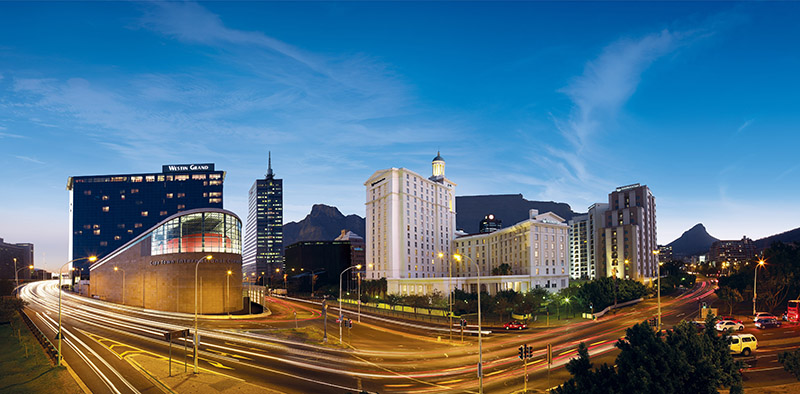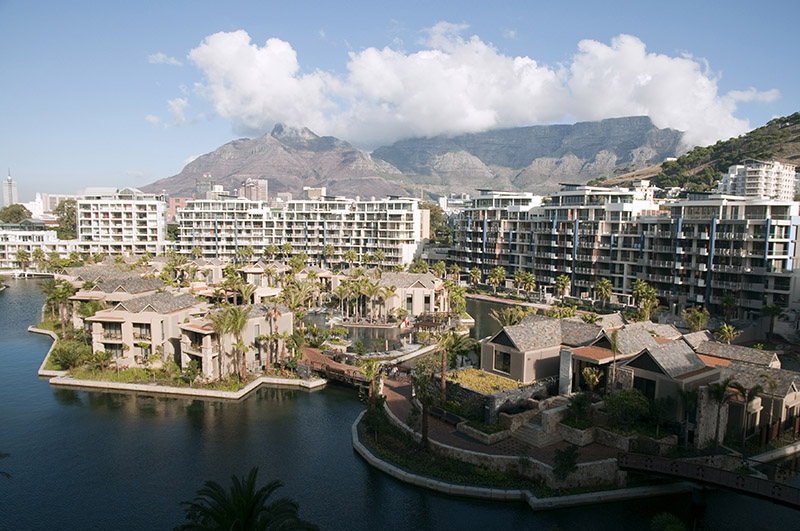Cape Town is a member of an elite club of the world’s most spectacular cities. Like its major rivals – New York, London, Paris, Rio de Janeiro, Hong Kong and Sydney – Cape Town offers more than beauty alone. It has brains, sophistication, mystery, a complex history, just a hint of danger, a keen eye for design and a head for business.
The second most populous city in South Africa, after Johannesburg, cosmo- politan Cape Town is the provincial capital of the Western Cape, a state blessed by nature. On the shore of Table Bay, at the northern tip of the scenic Cape Peninsula, Cape Town’s City Bowl is framed by Table Mountain, Devil’s Peak and Lion’s Head, forming a dramatic mountain backdrop. A series of inviting bays with affluent neighborhoods and eye-catching ocean homes extend out from the city along an exceptionally beautiful coastline.
But Cape Town is also a city of contradictions. Leafy suburbs of architect- designed villas are punctuated with dusty and impoverished townships. It has the scale of a provincial city with the sophistication of a first-world capital. At once European, African and South African – a melting pot of hip pavement cafes, raucous street traders and outdoorsy locals – Cape Town has emerged from a dark chapter of division to become a creative nexus at the southern tip of the continent.
Close to the meeting point of the Atlantic and Indian Oceans, and with fertile land and abundant water, Cape Town’s geography was fundamental to its rise. European ships heading to the Orient stopped at the Cape to stock up on water and food supplies. It was the Portuguese seafarer Bartholomeu Dias who first rounded the Cape in 1488 and named it the Cape of Good Hope.
Today it is a vibrant, creative energy that promises to reshape the city. Cape Town is this year’s World Design Capital, a designation bestowed biennially by the Inter- national Council of Societies of Industrial Design. Design Capitals are dedicated to using design to transform lives and better cities. Cape Town’s tenure, say organizers, is part of a broader vision to transform the city through design into a sustainable metropolis bridging historical divides and building social and economic inclusion.
Cape Town is celebrating design in all its forms, throwing open the doors to artists’ studios, putting on fashion shows by new and established designers, organizing architecture open houses and hosting a series of global design events. As part of the program, residents are seeking to rejuvenate impoverished townships like Gugulethu and Maboneng. One unique project sees township homes turned into public art galleries showcasing works crafted by local artists.
But it is still tourism that draws the vast majority of visitors to the city. In January, “The New York Times” ranked Cape Town at the top of its ‘52 Places to Go in 2014.’ Little wonder. Aside from its legendary beauty, few cities pack so much into such a small area.
  |
Table Mountain is the city’s most iconic landmark and a trip to the top by cable car or on foot – and abseiling back down for the intrepid – delivers unrivalled views of the city skyline, the beach community of Camps Bay and beyond. The late Nelson Mandela described Table Mountain, viewed from Robben Island, as a “beacon of hope.” Mandela spent 18 of his 27 years in captivity in the notorious maximum-security prison, but today Cape Town’s Alcatraz is an inspirational museum.
A scenic hour’s drive from the city, the spectacular Cape Winelands seem like they are a world away. Roll- ing vineyards, historic wine estates – many open to the public for tours, tastings and picnics – and neat towns like Stellenbosch, Franschhoek, Paarl and Robertson are the gateway to South Africa’s premier wine labels.
A quarter of the world’s shark species live in South African waters and about 40 of these call the Cape Town area home. Nearby Gansbaai is the “Great White capital of the world” and shark-cage diving is a once-in-a- lifetime experience. Less life-threatening is the Jackass Penguin colony at Boulders Beach allowing visitors to get up close and personal with the comedic birds.
Art and design, however, are two of the rapidly growing attractions of Cape Town. At the foot of Devil’s Peak, the rundown suburb of Woodstock is fast becom- ing Cape Town’s new arts center. Dilapidated Victorian buildings are being refurbished, derelict warehouses have been transformed into art galleries and boutique shopping malls and a new street art project is drawing interest. A district once associated with gang crime is now a Saturday staple for Capetonians flocking to the food market at the Old Biscuit Mill.
Given its diminutive size, Cape Town is a city best discovered on foot. But if its gentle slopes become too much, Cycology, a recent start-up business, offers bespoke tours on electric bicycles. Social entrepreneur Vincent Truter, a former Johannesburg advertising executive and a crusader for green mobility, founded the company to unlock a new way of seeing the city.
Another entrepreneur, coffee evangelist David Donde, founded Truth Coffee in The Fringe, the city’s innovation district. Cape Town is noted for good coffee, but Donde took that further by roasting and blending his own, investing in a three-ton vintage roaster. A steampunk- inspired interior for the flagship outlet on Buitenkant Street includes saw-blade tabletops, exposed pipes and a pressed tin counter. “MSN Travel” last year bestowed Truth with best coffee shop in the world status.
Cape Town may thrive with the buzz of innovation, but some city landmarks have stood the test of time. At the foot of Table Mountain and a short walk through the Company Gardens from downtown, the Belmond Mount Nelson Hotel is a Cape Town institution. Its manicured grounds offer an oasis of leafy tranquility amid the buzz of the city. Its grand exterior, painted powder pink since the Great War, has been a city landmark since the hotel opened its doors in 1899 to the First Class passengers of a shipping line.
Its reputation for providing the rich and celebrated with a home away from home is the stuff of legend. Winston Churchill stayed here as a war correspondent. Arthur Conan-Doyle was also a guest. In fact an A-list “who’s who” of power players has evaded the paparazzi within the hotel’s protective walls from Oprah Winfrey and Tiger Woods to Lenny Kravitz and the Dalai Lama.
A world away from the minimalist modernism of Cape Town’s boutique hotels, the affectionately named ‘Nellie’ is a masterpiece of English colonial design and decor. The 201 plush guest rooms fuse timeless charm with contemporary luxuries, each with its own unique character. Exquisitely furnished with marble bathrooms, most have fireplaces and all offer views across the hotel gardens, the fountain courtyard or Table Mountain.
Eight restored, historic cottages in the grounds have been converted into Garden Cottage Suites.
Cape Town is a gastronome’s dream and the Mount Nelson’s master chef Rudi Liebenberg is a passionate proponent of local ingredients. The Chef’s Table is an alcove of the kitchen that offers the perfect vantage point as Liebenberg and his team prepare a sequence of memorable dishes – the Biltong-dusted springbok loin with a chakalaka polenta croquette and beetroot salad is a stand-out dish – matched with wines from the Cape Winelands.
If you can’t reserve the Chef’s Table then the Planet Restaurant and Bar are excellent alternatives, packed with well-heeled Capetonians. Afternoon tea at the Mount Nelson is also a tradition well worth indulging. Elegant, graceful and resolutely glamorous, in the way of an aging screen siren, the Nellie is a city icon in an iconic city.
Image Credits: Photos courtesy of South African Tourism.


